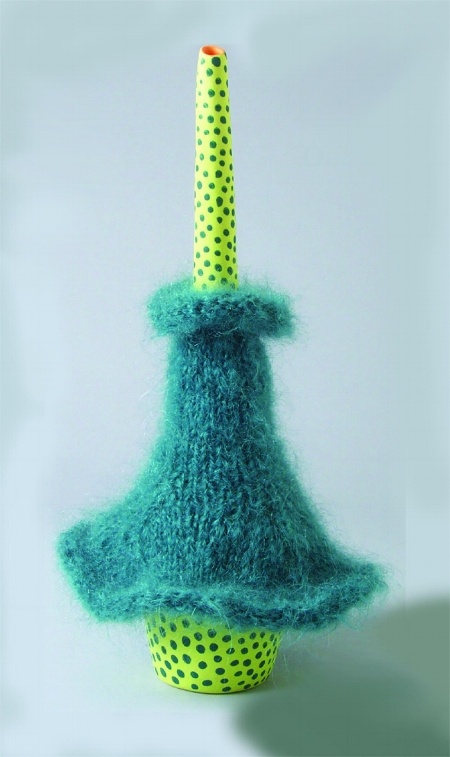2018 Ted Coons Dissertation Prize Winner: Mary Anne Davis
April 13, 2018
Interview by Sandra Stephens
Awarded to one graduate each year, the Ted Coons Dissertation Prize was established in 2015 to acknowledge outstanding IDSVA dissertations. It was made possible thanks to a generous donation by Dr. Ted Coons, Professor of Psychology, Cognition & Perception at the Center for Neural Science at NYU. Ted Coons is a pioneer in the field of neuroscience and a major contributor to early studies in neuroaesthetics.
This year’s Prize was awarded to Mary Anne Davis for her dissertation titled: The Ambiguous Object: Toward and Econo-Aesthetics through a History of Porcelain. IDSVA student Sandra Stephens interviewed Mary Anne about the relationship between her work as an artist, IDSVA, and her dissertation.

Your dissertation explores the genealogy of porcelain, and its move from, as you put it, "a precious element to a ubiquitous commodity." Can you tell us more about what you see as the potentialities with this move and the re-imaginings of porcelain?
Porcelain was not available as a manufacturing material until the eighteenth century in Europe. Prior to that, it was strictly available as a commodity, as an export from China. What that created was this history of porcelain that was very refined and very precious. Towards the end of the nineteenth century, it became part of the industrial possibilities. It is now used in plumbing and even in space travel.
Porcelain is just at the beginning of its tenure as an art material. Its durability gives it the property of a permanent trace, a trace that leaves the present within the material’s own genealogy and extends it into the realm of a broader category of art. Ceramics itself has a history that up until recently has been somewhat isolated. A paternalistic tendency has dictated the practice of ceramics and pottery. Clay has a lot to offer the art world as a material of expression and aesthetic assertion.
Porcelain has been critiqued for its fraught history and relationship to purity. How do you balance this history with its potentialities as an art material?
One of the things that I'm personally interested in is material neutrality. I think it is unfair to bog a material down with history because the material has nothing to do with the politics or the class consciousness that was part of its development. The material itself is beautiful matter and to chain it to its history negates its future as an emancipated medium capable of as yet unexplored territory. Important critiques of that history have been done, but it is time for a more expanded view.

Could you tell us a little about current projects you are doing with Davistudio and how your IDSVA experience has impacted that?
Davistudio is the commercial arm of my identity as an artist. I have a small staff and we produce porcelain dinnerware, serveware and giftware. The business is a practical application of what I articulated through the dissertation, Toward an Econo-aesthetics. I developed Davistudio as a way of establishing a living alongside the applied experience of being an artist in the world. Working in this practical manner, making discrete works of art, is like an atomization of my vision as opposed to the grandiose articulation of an individual vision. These smaller items go out into the world in the thousands every year, creating an impact on local economies. And that's my passion.
In your current Women in Power series, similarly to the way you brought the two dimensional in conversation with the three dimensional in previous works such as Pink Plaid Ovoids on Green Dot Silhouette, here you bring objects in conversation with the figurative. With these ceramic pieces, you dress them in clothes. I was wondering if you could speak more about that.
Women in Power is a feminist statement. I am interested in emphasizing under-recognized women of influence through my own lens and my own voice. The series is having a resurgence now because of the #metoo movement. I saw Mary Beard's new book Women & Power, in a local bookstore, got very excited and started talking to the owner about it. She offered me a show of the bottles and that has inspired revisiting the series and adding to it. So far, I have added Hannah Arendt, Gertrude Stein and Alice B. Toklas to the list and will keep going.

An engaged activism has been informed by my work at IDSVA. Although I have been an activist my whole life, I haven’t felt as brave as I feel now. I've written columns about local economies and I see how these local economies could be profoundly disruptive to oppressive regimes. Maybe today’s politics also warrant a more engaged intelligentsia. The combination has added motivation and commitment to my activities.
Although your dissertation research calls for a reclamation and mastering of the market, in an earlier blog you also see art as experimental and exploratory as well as not economically motivated. In some cases, you seem to want to preserve that space of art outside of the market. Can you speak to that and whether you think there needs to be or can be a space for some aspects of art to be outside of capitalism to help imagine other systems.
Absolutely. I think that there's a hierarchy of making in an artist's day today. There are times when I make art that is not for immediate consumption. There are times when I'm making art that has already been paid for. Artists can and must dictate and develop their own structures, their own methodologies. Having a day job to make money and then making art that has no part of an exchange system is one way, but my choice was to integrate my studio practice with my financial needs. When you put the work out there and you put a price on it and engage and exchange, it changes the stakes of making and being part of a broader discourse.
